|
|
9.3 out of 10 based on 19 ratings
9 out of 10 based on 21 ratings
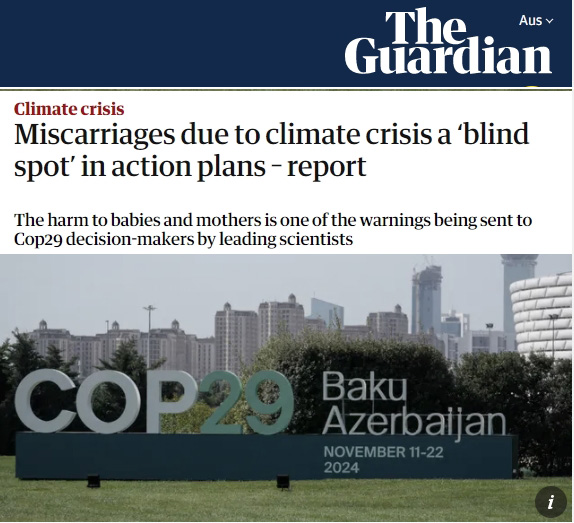
By Jo Nova
This week’s UN witchcraft is that a half a degree of global warming will kill babies and pregnant women, give us your money.
The UN COP29 meeting starting Nov 11th, fights for relevance in the shadow of the US Election, like a suckerfish under an aircraft carrier.
The latest confected attempt to get attention is to guilt trip the West — telling us that women and babies will die if we don’t install enough solar panels. This is despite humans being mammals which evolved to cope with the heat and the cold. We live a more closeted, protected existence than any time in the last million years. Not many people give birth in caves these days. Indeed we’re a species that inhabits towns with monthly temperatures that vary by 90 degrees Celsius and we are supposed to panic about another half a degree?
The truth is that being cold, poor and hungry increases stillbirths just as much as any heatwave, and the thing that saves babies on a hot day is an air-conditioner. The answer to all four killers thus, is cheap electricity and fossil fuels.
One day history students will study how the UN uses biblical paraphrasing to demand their tithe and control:
The report follows an ultimatum from the UN secretary general, António Guterres, on the climate emergency: “We’re playing with fire, but there can be no more playing for time. We’re out of time.” He said global heating was supercharging monster hurricanes, bringing biblical floods and turning forests into tinderboxes, and said governments had to rapidly wean the world off its fossil fuel addiction.
Naturally, only babies that die from heat stress are politically marketable, the UN doesn’t care about the ones that die from the cold:
Increasing climate extremes are causing more lost babies, premature births and cognitive damage to newborns, the report said. For example, a study in India found a doubled risk of miscarriage in pregnant women suffering heat stress, while another in California found a significant association between long-term heat exposure and stillbirth and premature birth.
Awkwardly, cold temperatures also cause stillbirths and miscarriages (Ruan et al) so if man-made climate change is warming the world, it must be saving babies too. Shh!
Five minutes of research, which the Guardian team don’t do, turns up a meta-study showing that poverty doubles the risk of death in babies:
Numerous studies confirm that mothers of low socioeconomic status and unemployed parents face a far higher risk of having a stillbirth or a low birthweight child [7–10]. It has been demonstrated that women or families living in adverse socioeconomic conditions have twice the risk of having a stillborn baby compared to their more privileged counterparts [11]. Unemployment and unfavourable economic conditions are usually associated with poor maternal nutrition, elevated psychological stress during pregnancy and limited access to medical supervision and prenatal care. Several studies show that pregnant women with elevated levels of stress have considerably higher risks of a stillbirth, independent of age, parity, education, smoking and alcohol habits or other compromising characteristics…. Moreover, in low income countries or deprived environments, poor maternal nutrition and low body mass index can result in higher stillbirth frequency [15]. — Tsimbos et al (2021)
Thus to save babies, and follow the science — we must burn more fossil fuels
Wealthier nations have higher CO2 emissions, more heaters, more air conditioners, better food, and their babies don’t die as often.
It is a crime the UN is not helping poor African nations build coal plants.
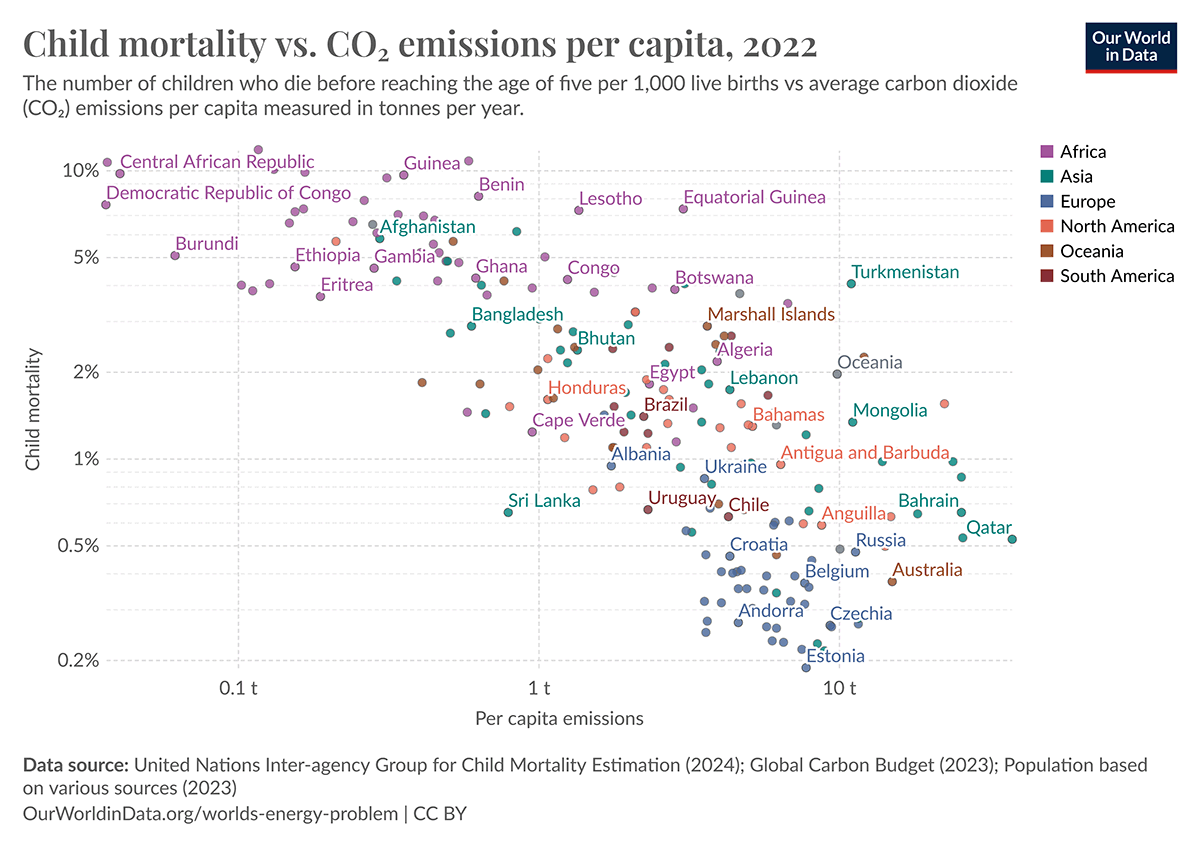 Child Mortality falls as CO2 emissions rise per capita. | OWID UPDATE#2: TonyfromOz asked where China was, and pointed out that it and many big countries were missing which is a great point. So here below are the top 25 largest in population plus a few other notables.
As expected, the largest countries almost all fall in the centre of the trendline.
 Child Mortality, CO2 emissions. OWID https://ourworldindata.org/grapher/child-mortality-vs-co2-emissions-per-capita
REFERENCES
Cleon Tsimbos, Georgia Verropoulou Dimitra Petropoulou (2021) Economic crisis and stillbirth ratios: Evidence from Southern Europe, PLoS One, 2021 Nov 18;16(11):e0259623. doi: 10.1371/journal.pone.0259623
Ruan T, Yue Y, Lu W, Zhou R, Xiong T, Jiang Y, Ying J, Tang J, Shi J, Wang H, Xiao G, Li J, Qu Y, Mu D. Association between low ambient temperature during pregnancy and adverse birth outcomes: A systematic review and meta-analysis. Chin Med J 2023;136:2307–2315. doi: 10.1097/CM9.0000000000002361
9.9 out of 10 based on 82 ratings
10 out of 10 based on 11 ratings
By Jo Nova
Spare a thought for the people of Cuba
The situation went from awful to something much worse.
They ran out of working electrical plants ten days ago, and endured blackouts lasting for four straight days, including one hurricane. Reports coming out suggest that though electricity is partly restored, it’s often only for four hours a day. Not surprisingly, the country is semi-paralyzed — schools are still closed and “labor services” are largely non-existent, apart from hospitals, funerals and efforts to repair the damage caused by Hurricane Oscar.
Soon they may run out of people. People were fleeing Cuba before things got this bad.
The big blackout began on Friday October 18th. In the next four days they restarted the grid three or four times only to have it crash again, and while power is sort of mostly restored the structural problems appear to be dire. Nothing really sums the state of the communist economy better than one line on Vox news which described the moment the big blackout began:
“Seven of the country’s eight thermoelectric plants, which generate power for the island, were not working or under maintenance prior to the Guiteras plant’s failure. So when the Guiteras plant shut down, there were no more energy sources.”
As if “seven out of eight” is not bad enough, there’s more. Cuba can’t get subsidized fuel anymore from Russia, Mexico or Venezuela, and they can’t afford to buy fuel at market prices. The economy is kaput. They don’t make many things that the world wants to buy, and tourism dried up with the pandemic.
It appears that either the only surviving plant suffered a malfunction, or the nation actually ran out of fuel, or both. Reuters is somewhat vague:
Reuters
Long-time ally Venezuela slashed fuel shipments to Cuba by half this year as it struggles to assure supply at home. Allies Russia and Mexico have also cut exports to Cuba, forcing the cash-strapped government to seek far pricer fuel on the spot market.
The situation came to a head on Friday, when Cuba’s largest power plant malfunctioned, joining several smaller plants already offline. Foul weather had also stalled the arrival of fuel from tanker ships offshore, starving the island’s power plants. The combination prompted the entire grid to collapse.
Life is tough. Generators were only able to power hospitals for emergency situations.

People are collecting wood in the streets so they can cook anything for dinner. Even before the blackout some 600,000 had no running water, and now that is worse. The BBC reports that some are now going hungry.
Predictably there are fears the exodus will grow
The word is that the government won’t let people protest the dire living conditions, but it will let them leave, so one million people have left in the last three years. (There go the dissidents, the ambitious, the motivated, and often the brightest). Since Cuba had a population of around ten million, effectively ten percent of the country left since 2021.
There are fears this will only increase:
This crisis could fuel a further exodus; an estimated 1 million Cubans have left the country in the past three years, the largest such migration in the country’s history. One Havana-based economist, Omar Everleny, told the New York Times he’s already starting to see a new wave of emigration: “Anyone who was thinking of leaving is now accelerating those plans. Now you’re hearing ‘I am going to sell my house and go.’”
By Martin Gurri, The Free Press
This is not an exaggeration or a metaphor. The entire island went dark—even Havana, which has been protected from the worst of the recent blackouts. It was a civilizational breakdown. The economy quite literally ground to a halt, as factories and stores were ordered closed by the government. From elementary schools to universities, the educational system was put on pause. Hospitals turned people away. For three days, Cuba, already tattered and abused, entered a special circle of hell reserved for the most mismanaged nations on earth.
The material catastrophe is self-evident and can be measured empirically. The depth of human suffering is impossible to gauge from a distance. Without refrigeration, food—always hard to obtain—was spoiled. Mothers lacked milk for their children. Without fans or air conditioners, everyone, including the very young and the very old, was exposed to Cuba’s blistering temperatures. Without elevators, the old and the sick who lived in apartments were forced to sleep outdoors, in the heat and among the mosquitoes. Without traffic signals, venturing to the streets became a death-defying nightmare. Without light, the human mind itself begins to shut down—the Cuban public, frozen in place by an incompetent and antiquated regime, sank to almost metaphysical levels of hopelessness.
Bad governments can ruin a lot of lives:
People are angry. Online many people complain that the government built many fancy hotels for tourists, instead of fixing the electricity grid for the people.
Despite the crisis and the hurricane, Cuba’s President Miguel Díaz-Canel somehow found the time to advise the citizens that “if they protest on the street they will be prosecuted”. He put on military garb and said the protestors were just drunks, as if sober people would not mind having no functional economy.
 … It’s hard to get stories out of Cuba but ex-pats or friends outside Cuba post opinions on Reddit and they are gloomy.

The problems in the Cuban grid have been decades in the making.
The eight power plants are largely crude fuel oil plants of about 400MW. In total, theoretically, they could generate 2,500MW. In actuality, they are badly built, badly maintained, and 30 to 40 years old. Power generation has declined by 25% in the last five years.
Ruaridh Nicoll in Havana, The Guardian
“It’s very hard to restart a power station,” said a retired engineer from Antonio Guiteras, who asked to remain anonymous. “You need to produce a lot of electricity just to get it going.”
Antonio Guiteras was built in 1989, and is now battered and obsolete. “The truth is that it was built rotten,” said the engineer. He told harrowing stories of working with faulty safety equipment, political management who would disappear when problems arose and a system long pushed to its limit.
“There was a scheduled maintenance programme, but it was never followed,” he said. “The requirements were too tight. We were told: ‘The factory has to produce, so patch it up.’”
Somehow, despite Cuba being almost a failed state, there are glorious plans to build 26 solar farms with a capacity of one gigawatt. As the Guardian tells it, China has offered the parts to make them, in return for access to Cuba’s nickel deposit. Though there are fears that the people who might have been able to build the solar plants have already left Cuba. What then?
The gigawatt of solar (if it even happens) will only provide about one third of existing demand at most, and will obviously only work in the middle of the day, and possibly not at all after the first hurricane. As Broken Hill, and Alice Springs know, when things are desperate, solar panels are not the answer. Baseload comes first.
If Cuba can’t get fuel oil, and get the grid functioning, surely food and water will run out, and people will be forced to make some very tough decisions.
If the grid can’t supply enough energy for the people, in the capitalist world the answer is “more grid” but in the communist world, it apparently means “less people”. In this case Cubans are “lucky” enough to be allowed (at the moment) to walk or swim away, but for how long?
h/t Chad and another ian.
h/t Tony Thomas one mega corrected to giga…
10 out of 10 based on 77 ratings
9.3 out of 10 based on 15 ratings
By Jo Nova
The lights went out in Broken Hill. A storm blew seven transmission towers over disconnecting the area from the national grid on October 17th. About 19,000 people live there, and with a 200MW wind plant, a 53MW solar array and a big battery, plus diesel generators it was assumed they’d be OK for a while without the connection to the big baseload plants, but instead it’s been a debacle. They’ve had nearly a week of blackouts with intermittent bursts of power, barely long enough to charge the phone.
The fridges in the pharmacies failed, so all medications had to be destroyed and emergency replacements sent in. Schools have been closed. Freezers of meat are long gone… Emergency trucks are bringing in food finally and hopefully the schools will reopen today. But the full reconnection will not happen until November 6th.
By Joanna Panagopououlos and Alexi Demetriadi, The Australian
Mayor Tom Kennedy said state and federal governments “needed to learn” from the experience, and how wind and solar energy are “almost useless” in a crisis without baseload power.
“(Wind and solar) are worse than useless (in a crisis like this), because it’s detrimental to having a consistent power supply,” he said. “I’d hate to see what happens in the capital cities in a similar crisis.”
The bad news is that when there is no reliable 50Hz baseload supplier of electricity, the solar panel inverters just don’t mesh well with the diesel generators. The frequency of the diesel generators varies slightly as the load changes, and these fluctuations cause issues with solar inverters, which need a stable frequency to synchronize properly.
Hence, in a blackout, the solar panels were not just useless, they were a threat to the system, so people were asked to switch them off:
Essential Energy on Friday was urging customers in Broken Hill to switch off their solar supply main switch to protect the 40-year-old backup gas-turbine generator providing power to the town and surrounds.
From within Broken Hill, a forlorn Jack Marx is dotting out his story in The Australian via his phone:
…Broken Hill, has been in blackout for five days.
The power comes on from time to time, but goes out just as quickly. It gives us just enough time to power our phones and read emails from energy providers sent the day before, alerting us to the fact the power was about to go out. They also warn we don’t have much time, and to avoid using unnecessary electrical devices – air conditioners, fridges or fans that need a power point.
The unreliable generators survived the storm but were still useless. Giles Parkinson suspects (fervently hopes) that this is just a bureaucratic issue, rather than a technical one:
Giles Parkinson, RenewEconomy
The fact that the wind farm and the solar farm aren’t operating with the transmission line is understandable. But the big battery is supposed to be – and that could in turn have allowed the wind and solar to produce. No one is saying what’s gone wrong, but many suspect it’s a matter of oversight rather than technology.
“You need to talk to Transgrid,” said one. “You should talk to Essential,” says another. “Ah, that’s AGL’s asset, you better talk to them.” And then. “No, Tilt Renewables own those. Give them a ring.” And finally, “we don’t have an official statement now, but we are trying to sort it.”
It certainly was mismanaged. But that’s just it, isn’t it? A decentralized grid has a million moving parts, and thousand agencies that can all screw up together. Complexity has a cost. But it’s not just mismanagement,a wind and solar system is not just expensive, but lacks inherent stability. Sure, eventually, if we hock the nation we can find a way, but why? To make storms nicer in a hundred years?
Solar power is not just superfluous, it’s toxic
The big Broken Hill battery finally restarted on Saturday to help the town cope with the evening peaks in demand for electricity. But the intrinsic problem remains in these remote communities, erratic solar power doesn’t work well with diesel gens, and everything needs to be fully backed up in any case. As we saw in Alice Springs, it didn’t take much solar power, for one big cloud to cause a blackout. The Northern Territory was so scarred by that blackout in 2019, they’ve left 4 solar plants sitting there idle ever since, in fear they’ll crash the Darwin-Katherine grid.
So much money and so little to show for it:
Even with a price tag, our renewables future is already broken
Nick Cater, The Australian
The Silverton Wind Farm and Broken Hill Solar plant were supposed to produce enough electricity to power 117,000 homes. They’re supported by AGL’s 50MWh battery facility at Pinnacles Place, one of the largest in Australia. Yet Broken Hill, population 19,000, has been in a semi-permanent state of blackout since a storm brought down the transmission line connecting the town to the east coast grid.
Some $650m worth of renewable energy investment within a 25km radius of Broken Hill has proved to be dysfunctional. The technical challenges of operating a grid on renewable energy alone appear insurmountable using the current technology.
Instead of spending $650 million dollars on solar and wind and a battery, we could have bought two brand new useful diesel generators for every remote town in Australia, and then when transmission towers fall down, they won’t be left in the dark.
9.9 out of 10 based on 125 ratings
8.8 out of 10 based on 16 ratings
8.9 out of 10 based on 20 ratings
The millionth comment came in this afternoon (on the Friday thread). Congratulations to Simon Thompson M.B. B.S. for the millionth comment. With Yarpos at 999,999 and Old Ozzie at one million and one.
For the record, I’ve emailed all three and offered to post them a set of books, with thanks.
Of course, this really is an achievement of all the commenters who share their thoughts and expertise on a world of absurdities, and thanks to the tireless moderators who made it possible.
And thinking of those great minds who shared so much and are no longer with us…
— Jo
9.8 out of 10 based on 102 ratings
 The World Bank — Who We Are. As they say — we’re “Accountable to ourselves”. By Jo Nova
The World Bank is the largest climate funding multinational blob on Earth, and the world is about to end, the oceans are about to boil, but no one at the World Bank can explain where billions of dollars worth of the Earth saving funds have ended up. It’s almost as if no one there gives a toss about the climate. Indeed, if the World Bank was a giant parasitic squid feeding off the taxpayers of the West, it might look just like this.
A new Oxfam report shows that over six years, $24,000 million dollars (at least) has probably gone missing off the balance sheets, but it could be as much as $41 billion. Essentially, the World Bank budgeted to spend a lot of money, but no one bothered to track whether that money was spent, whether the budget blew out, or whether it never happened and the team went surfing in Costa Rica. Imagine if we could do our taxes this way? Indeed, it’s a bit rich to say the money was “missing off balance sheets” because apparently there weren’t any balance sheets, not for expenditures.
Oxfam can only guess at the missing sums because they investigated other World Bank projects and found the final cost differed from the planned cost by between 26 to 43%. So they used that to come up with a ballpark figure of the size of the missing millions. It’s that bad. We can’t even say how much is missing. One insider told the New York Post, “it could be twice or ten times more”.
The supranational unaccountable entities like the World Bank, the UN, are surely the great attractor of global freeloaders. Like a supermagnet for people who like spending other people’s money:
By James Franey, New York Post
What if it wasn’t bungling — who would know?
Bungling World Bank bureaucrats lost track of at least $24 billion bankrolling the battle against climate change, according to a bombshell report by a left-leaning charity group.
An investigation by Oxfam revealed “poor record-keeping practices” by the DC-based international lender that resulted in anywhere between $24 billion and $41 billion in misplaced funds.
The agency’s audit showed “a lack of traceable spending” over the past seven years — partly because of an oddball accounting practice in which the bank accounts for its climate financing at the time of a project’s approval rather than at the time of project completion,…
In the report: Climate Finance Unchecked Oxfam discovered that it was extremely difficult to get simple answers:
“We had to sift through layers of complex and incomplete reports, and even then, the data was full of gaps and inconsistencies. The fact that this information is so hard to access and understand is alarming —it shouldn’t take a team of professional researchers to figure out how billions of dollars meant for climate action are being spent.
This could all be sorted out in five minutes. All it would take is for our governments to say “No more money for the World Bank until it sorts out reporting”, and next thing you know the World Bank would be filling out tax returns. But the odds of this happening are like an asteroid strike — unless Donald Trump wins the US election (above the margin of cheating). Mere mortal politicians who ask hard questions, not only risk their post-political Blob career with the UN-WEF-World-Bank-IMF-FAO-WHO-IAEA-or-OECD, they might feel the force of a World Bank report telling their citizens how they mismanaged their own economy, and who wants that?
The amounts of money are mind-blowing
The Oxfam writers, bless them, are slightly baffled. With the world in dire straits (as they see it) they can’t figure out why the World Bank is not treating every dollar like a diamond.
…the sums needed are vast and growing: According to the UN’s Adaptation Gap Report 2023, the amount needed for
adaptation finance alone stands at between US$215 billion and US$387 billion a year.
There is so much potential. If the World Bank got what it asked for, and spent 90% in an honest way, there would still be $30 billion dollars left to throw parties. But if no one is tracking any of it, why not think big?
“This is the wild, wild west of finance,” said Mark Joven, Philippines Department of Finance undersecretary, who represents the country at U.N. climate talks. “Essentially, whatever they call climate finance is climate finance.”
“You cannot really follow the money, track the money, track the impact,” said Romain Weikmans, a senior research fellow specializing in climate finance at the Finnish Institute of International Affairs.
–“Rich nations say they’re spending billions to fight climate change. Some money is going to strange places.” Reuters.
Big Government feeds Bigger Government
The Globalist Blob not just The Promised Land for political grifters, on a practical basis, the more they can siphon from the people towards the blob — the more friends they make in the international blob-glitterati, and the better chance they have of being offered the next great blob job offer.
Medium level domestic bureaucrats are surely looking to the land of milk and honey, which is where taxpayer funds escape the event horizon of audits and elections. Only there, can the parasites do whatever they want with other people’s money.
Download Oxfam’s new report “Climate Finance Unchecked.”
9.9 out of 10 based on 108 ratings
Comments standing at 999,872
At 1:12AM Queensland time Friday.
UPDATE: Congratulations to Simon Thompson M.B. B.S. for the millionth comment. With Yarpos at 999,999 and Old Ozzie at one million and one. 19.2
9.1 out of 10 based on 21 ratings
By Jo Nova
For some reason more than a thousand whales, dolphins and porpoises died around the UK’s coastline every year for the last eight years. This is roughly twice as many as in the 25 years before that. What could it be?
Whatever it is, it isn’t windfarms. Greenpeace says so:
“There is no evidence whatsoever linking offshore wind to whale deaths. The manufactured hysteria is the result of fake news promoted by politicians, big oil, and their cronies to save the oil and gas industry”
Greenpeace Australia says wind-plants save whales.:
…”building offshore wind is way, way better for ocean wildlife than fossil fuels”.
And yet there are a thousand dead cetaceans.
Andrew Montford of NetZeroWatch graphed beached dolphins, whales and porpoises against the rise of a new industrial marine machine:
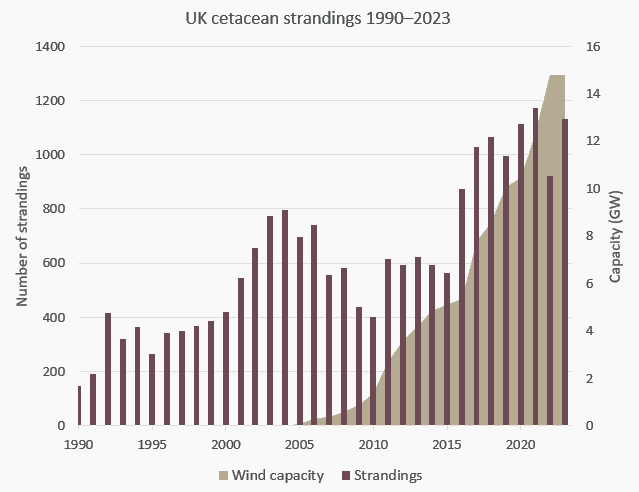 Cetacean Strandings in the UK graphed against offshore wind capacity. @Dissentient There’s no evidence, say Greenpeace, sounding just like Philip Morris.
We don’t know for sure what is causing so many whales and dolphins to die, but Greenpeace doesn’t even want to find out. The only thing we do know is that Greenpeace is craven, counterfeit, eco-imposter front for the Globalist Blob. As Matt Ridley said what happened to the Precautionary Principle?
Jason Endfield is tracking the carnage:
The UK’s 2023 annual report to Ascobans* reveals an appalling level of cetacean deaths in British seas, and comes in the wake of record-breaking increases in whale, dolphin and porpoise mortality in recent years. This shocking statistic should be a wake-up call to those planning to further industrialise our seas …
Researchers have known since at least 2013 that pile drivers were permanently deafening porpoises, leaving them, presumably to die miserable deaths wandering blindly through dark or murky seas. Where were all the professors of marine science, paid by the public to know these things, and where was the BBC?
They were all silent for ten years until someone invented and tested “bubble curtains” to protect porpoises, and then they could say “well isn’t that clever”?
Spread the word: fifty years ago environmentalists would have raised hell about a thousand dead whales and dolphins. Today they are a part of the cover up. They’re not even blaming climate change and 0.001 degree of warming. They don’t want to draw attention to the blubber on the beach in case people start asking hard questions.
Greenpeace, WWF, UNEP, they’re all fake environmentalists.
h/t Willie Soon.
10 out of 10 based on 109 ratings
Current tally 999,697 comments …
@ 1:20AM EST
10 out of 10 based on 12 ratings
By Jo Nova
Nobody checked the carbon-13 ratios!
Wouldn’t you know it — 150 nations signed the Global Methane Pledge without even bothering to check if the methane was man-made.
Methane — the second most hated Greenhouse gas — spiked to record historic levels in the last few years, over 1,900 parts per billion. In 2019, even the WEF scientists admitted they couldn’t explain the baffling rise, and then in 2020, the world of methane went into the twilight zone. We shut down the modern world due to the pandemic, and methane levels rose even faster.
It seems many have been blaming fossil fuels for the global surge in emissions, but forgot to check the C13 isotopes. Somehow we spend millions on breathalysing cows, measuring their burps, and feeding them seaweed, but didn’t think to do the basic chemistry. How could that be, you might wonder… 158 nations agreed to cut methane emissions by 30% by 2030, but none of them audited the science even though very strange things were happening. (The point was obviously the “pledge”, the junkets, the captive industries and subsidies, anything but the science).
Methane from fossil fuels has a higher carbon-13 ratio, but even though fossil fuel use was rising, the carbon-13 levels of atmospheric methane was rolling down a hill. Indeed this new study shows it’s been falling for 17 years.
It’s not like this snuck up on us…. any inquiring mind should have seen this coming a decade ago. The lab has been recording C13 in methane since 1998 and gets air samples from 22 sites around the world every week or two.
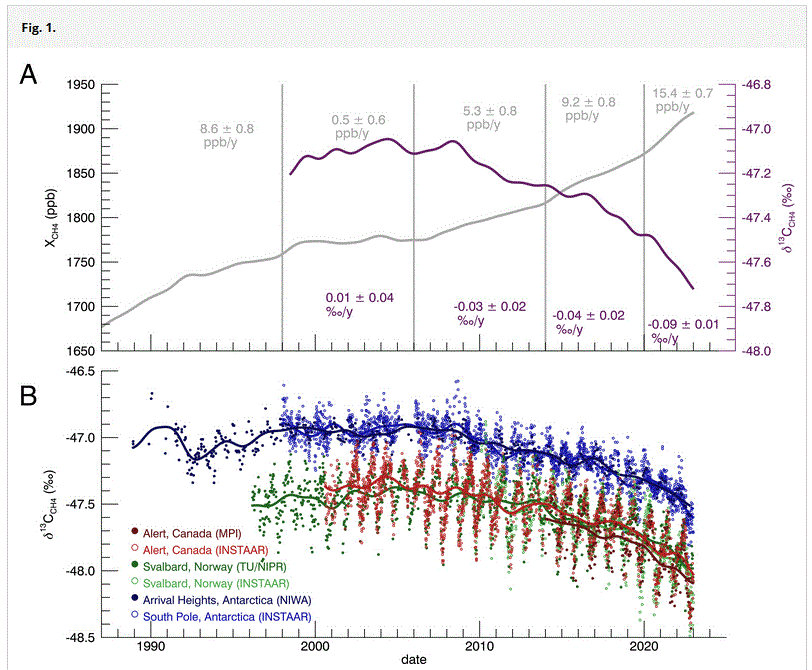 (A) Trend of globally averaged CH4 abundance (in gray) and δ13CCH4 (purple) from the NOAA/GML GGGRN. Mean growth rates of CH4 mole fraction and δ13CCH4 are shown for the following time periods: 1983–1998, 1999–2006, 2008–2014, 2014–2020, and 2020–2022. (B) Colocated δ13CCH4 measurements at Alert (Canada), Svalbard (Norway), and Antarctica by INSTAAR, NIWA, TU/NIPR, and MPI. Each dataset is fitted with a trend in the same color. PNAS From the press release:
They found that between 2020 and 2022, the drastic increase in atmospheric methane was driven almost entirely by microbial sources. Since 2007, scientists have observed microbes playing a significant role in methane emissions, but their contribution has surged to over 90% starting in 2020.
“Some prior studies have suggested that human activities, especially fossil fuels, were the primary source of methane growth in recent years,” said Xin (Lindsay) Lan…
“These studies failed to look at the isotope profile of methane…
They go on to mention that in a warmer world, bacteria have a higher metabolism, which means they are happier and work faster. Thus, like CO2, if the world warms for any reason at all, methane will rise — and there is nothing we can do about it.
The one last straw they could clutch is that maybe the microbes were “man-made” :
It remains unclear whether the increased microbial emissions came from natural sources like wetlands or human-driven sources, such as landfills and agriculture. The team plans to delve deeper to identify the exact source of methane.
As if somehow there was a surge in landfill, rice paddies or cows in the last few years that no one had noticed.
This is a pretty big deal — methane has supposedly caused about 30% of our current temperature rise (says the broken climate models) yet 90% of that recent rise was microbes. It’s yet another slice of the climate we aren’t controlling, but we’re still designing burgers with mealworms and bacon from fungus, in the hope of reducing methane emissions and controlling the weather. Then it turns out every swamp and square meter of soil is working against us.
Methane concentrations in the air have almost tripled since the 1700s, but that was the Little Ice Age. It’s easy to believe that as the world warmed up, the planet’s wetlands and soil microbes have just been returning to normal business for the last 300 years.
We skeptics told the experts long ago it was mostly not man-made, Tom Quirk showed that methane rises and falls in time with El Ninos, and was thus largely a natural phenomenon. Willie Soon also pointed out that one of Saturn’s moons has more methane than all the oil and gas deposits on Earth, but has no dinosaurs, cows or leaky wells.
REFERENCE
Michel, Sylvia Englund, et al (2024) Rapid shift in methane carbon isotopes suggests microbial emissions drove record high atmospheric methane growth in 2020–2022, Proceedings of the National Academy of Sciences. DOI: 10.1073/pnas.2411212121
10 out of 10 based on 89 ratings
And the tally stands at 999,548…
@ 2:49AM EST
9.8 out of 10 based on 20 ratings
Lest I forget, the comment count stands at around 999,405. 999,520 @ 5:06 EST. Sometime in the next few days we will hit one million.
9.9 out of 10 based on 45 ratings
By Jo Nova
There are a million pointless ways the Deep State Machine can tie down opponents.
Elon Musk is having fun sharing his stories of Bureaucratic Entanglement, as petty officials demand he protect sharks, whales and seals in every launch.
Bureaucrats are not even pretending to serve the people anymore, they just serve themselves
The Lordships at the Californian Coastal Commission have admitted they are disallowing extra Space X launches from Vandenberg Space Force Base because they don’t like Elon’s tweets. And they even said so out loud. It’s so third-world.
Commissioner Gretchen Newsom apparently has a theory that stopping rocket launches will protect the people of California from hearing opinions she doesn’t want them to hear. She has appointed herself decider of your vote.
“Right now Elon Musk is hopping about the country, spewing and tweeting political falsehoods and attacking FEMA while claiming his desire to help the hurricane victims with free Starlink access to the internet,” said Newsom, who has no relation to Gov. Gavin Newsom.
Newsom claimed Musk harbored an anti-California agenda, saying the CEO had enjoyed billions of dollars in state subsidies while threatening to relocate his companies to Texas due to “bigoted beliefs against California’s safeguards and protections over our transgender community.” — Wall Street Journal
In other words, it was just a form of extortion. She was hoping she could exploit her public role to force Musk to endorse the politicians and causes she personally preferred. Unfortunately for her, Musk is suing them all instead. He claims he has a right to free speech…
So at this point, despite being the richest man in the world, Elon Musk knows the people in control of the Army, the Spies, and the six trillion dollar budget could take it all away from him in a blink. Which is why he is all in with Trump, and if a few million dollars here or there might shift the outcome, it’s nothing.
In his latest volley back against the Machine, Musk wants people in swing states to sign a petition to protect the First and Second Amendments. In the world we thought we lived in, he would have spent millions on the mainstream media for advertising. Since the media are the enemy, to get attention, he’s decided to pick one lucky person each day who signed the petition, and give a million dollars to them instead. Fans of Kamala are crying foul, as though he is “buying votes” but since the petition is endorsing the First and Second Amendment, Democrats can sign the petition too, and (in theory) the Democrats support the Constitution. Yes? And if the Democrats don’t, then now would be a good time for American voters to find that out.
It’s so much better than feeding the Machine.
9.9 out of 10 based on 129 ratings
9.3 out of 10 based on 19 ratings
9.2 out of 10 based on 19 ratings
|
JoNova A science presenter, writer, speaker & former TV host; author of The Skeptic's Handbook (over 200,000 copies distributed & available in 15 languages).

Jo appreciates your support to help her keep doing what she does. This blog is funded by donations. Thanks!


 Follow Jo's Tweets
Follow Jo's Tweets To report "lost" comments or defamatory and offensive remarks, email the moderators at: support.jonova AT proton.me
Statistics
The nerds have the numbers on precious metals investments on the ASX
|


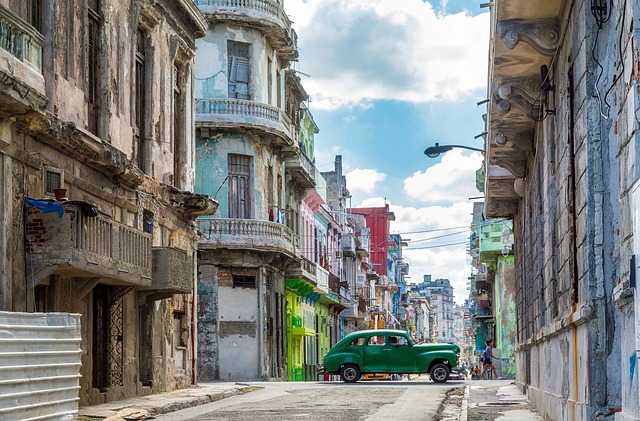


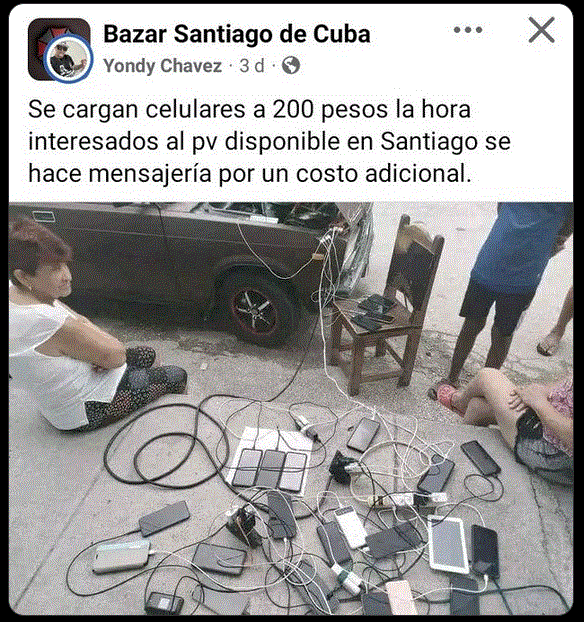



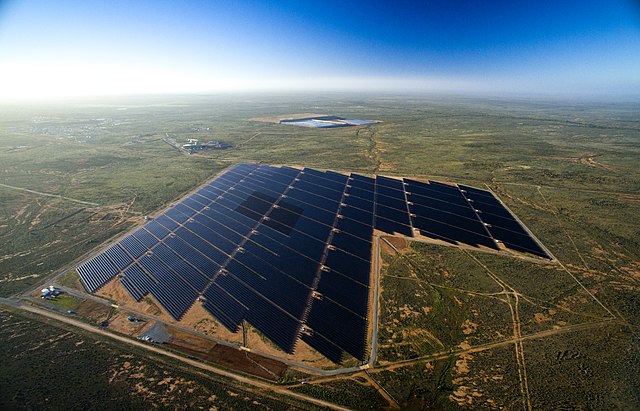
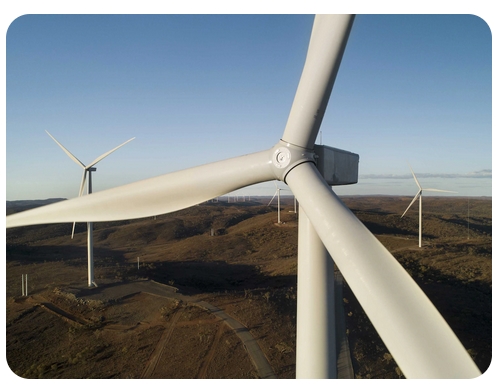















Recent Comments